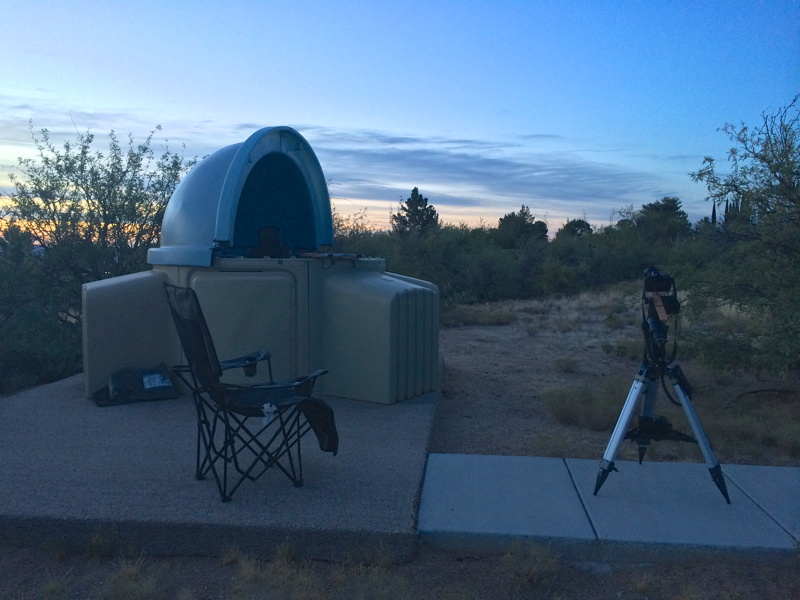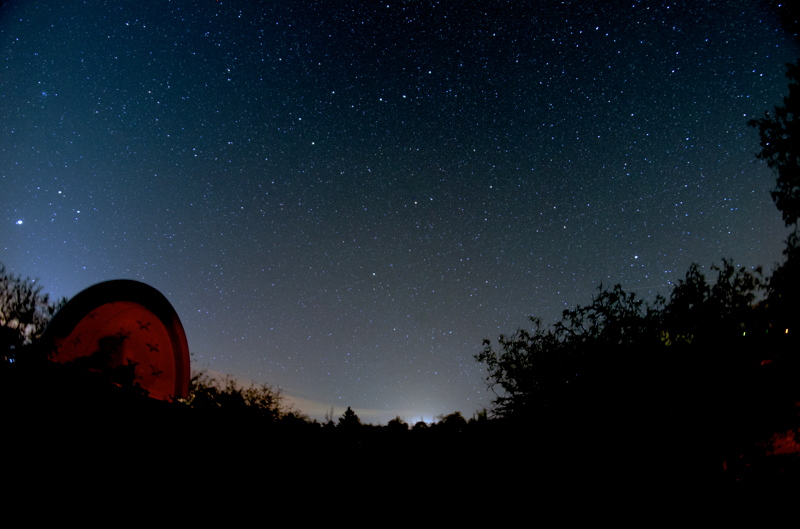
Mars, Camelopardalid Meteors
Posted: 24 May 2014
|
Opened: Friday, 23 May 2014, 1912 MST Temperature: 79°F |
Session: 688 Conditions: Clouds SW to NE |
Even though there were clouds in the sky I decided to open the observatory and set up for watching and hopefully photographing the Camelopardalid Meteor Shower, predicted to be at its peak from 2300 MST to 0100 MST. As the sun set I took this (cropped) photo using the D7000 DSLR with 8mm fisheye lens showing the clouds from the southwest through northeast:

This was the setup for watching and photographing the meteor shower, with my folding recliner in front of the observatory and the D7000 DSLR with 8mm fisheye lens on a LXD55 mount:

While waiting for astronomical twilight to end, I did some planet observing. At 1939 MST, began observing Jupiter, 83X and 222X. Two moons were visible (Callisto and Europa). At 222X, Europa's shadow was visible in transit near the central meridian. Seeing was not very good (clouds). At 1952 MST, viewed Mars, 222X. The North Polar Cap and Chryse Planetia were visible, but seeing was not good. At 2001 MST, seeing was a little better. Viewed Mars at 444X. Began setting up for iPhone 5s afocal slo-mo (120 fps) video recording, 666X + one Variable Polarizing Filter. This is a stack of 1120 frames (10 seconds of video) taken at 2008 MST:

2012 MST: the clouds had not moved much during the past hour, so I began to have hope that they would not interfere with viewing the Meteor Shower. Viewed Mars, 666X, but it was too much magnification for the current seeing conditions. 2020 MST: switched back to 222X; a much better view of Mars. A possible sunset cloud was visible near the Martian equator. 2042 MST: viewed Saturn, still low in the southeast, 222X. Four moons were visible: Titan, Rhea, Dione, and Tethys. At 83X, the view of the planet and its moons was very nice. 2100 MST: took a quick look at M13 and M92 globular clusters in the constellation of Hercules, 83X. Then slewed the telescope back to Saturn.
2105 MST: did some quality measurements; the clouds brightened the sky somewhat, but the Zodiacal Light was still visible. Dark Sky Meter Pro reported 21.44; a Unihedron SQM-L reported 21.12.
I then began preparations for sky imaging. This f/5, 2 minute (tracked), ISO 5000, 8mm fisheye lens, photo (180° diagonally), taken at 2116 MST, shows the observatory, the clouds low in the sky, the Big Dipper (upside down, top), with Jupiter (in Gemini) at the left, and the constellation of Lyra rising in the east (right):

After taking the above photo I returned to the house to get a warmer coat as there was a little wind chill from the breezes that had started blowing. Returned to the observatory at 2129 MST and put the telescope to "sleep".
2130 MST: I began watching for Camelopardalid meteors. 2209-2218 MST: short break to get long underwear; it was getting nippy with the breezes.
2236 MST: saw my first probable Camelopardalid meteor. It went through the constellation of Hercules and was fairly bright.
2248 MST: did some more sky readings: Dark Sky Meter Pro 21.36; Unihedron SQM-L 21.18. Still hampered by thin clouds.
2300-2330 MST: no meteors seen.
2343 MST: Camelopardalid meteor below Polaris. 2355 MST: bright Camelopardalid meteor in Leo.
2330-0000 MST: 2 Camelopardalid meteors seen during this half-hour period.
0003 MST: began sky imaging, f/5, 2 minutes (tracked), ISO 5000, 8mm fisheye lens.
0013 MST: nice non-Camelopardalid meteor.
0000-0030 MST: no Camelopardalid meteors.
0058 MST: sky readings: Dark Sky Meter Pro 21.15; Unihedron SQM-L 21.33. Still some thin clouds.
0030-0100 MST: no meteors.
0105 MST: nice Camelopardalid meteor moving southwest from handle of Big Dipper (but I wasn't imaging at that minute). 0111 MST: Camelopardalid meteor moving south through Little Dipper. 0117 MST: non-Camelopardalid meteor moving towards the Little Dipper. 0127 MST: non-Camelopardalid meteor near Cygnus.
0100-0130 MST: 2 Camelopardalid meteors, 2 non-Camelopardalid meteors.
0147 MST: Camelopardalid meteor near zenith (no imaging).
I ended sky imaging at 0159 MST.
0130-0200 MST: 1 Camelopardalid meteor.
Began closing up.
|
Closed: Saturday, 24 May 2014, 0232 MST Temperature: 56°F |
|
My total Camelopardalid meteors for the 4 hours 30 minutes of watching was 6, with 3 non-Camelopardalid meteors seen. Not exactly an exciting meteor shower, but it was good to see some meteors from Comet 209P/LINEAR.
During my initial image post-processing after closing the observatory I did not detect any meteors in my sky photographs. However, after getting about 3 hours of sleep, I went through the images again and found two with meteors:


Comments are welcome using Email. If you are on Twitter you can use the button below to tweet this report to your followers. Thanks.
Cassiopeia Observatory Home Page